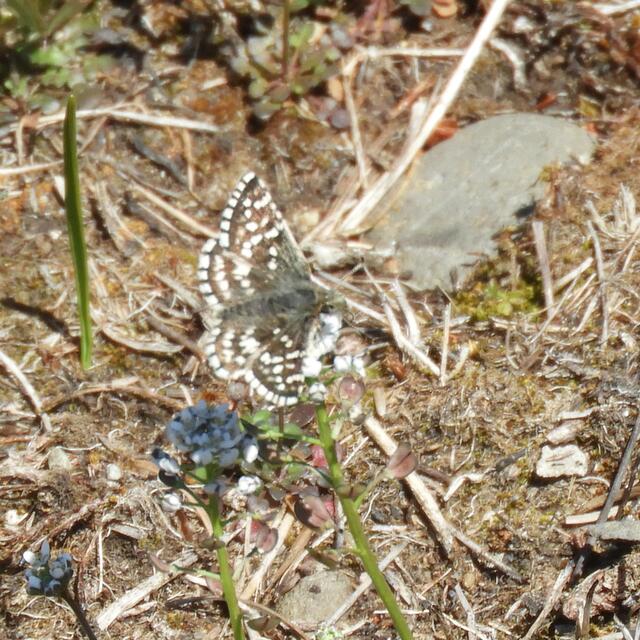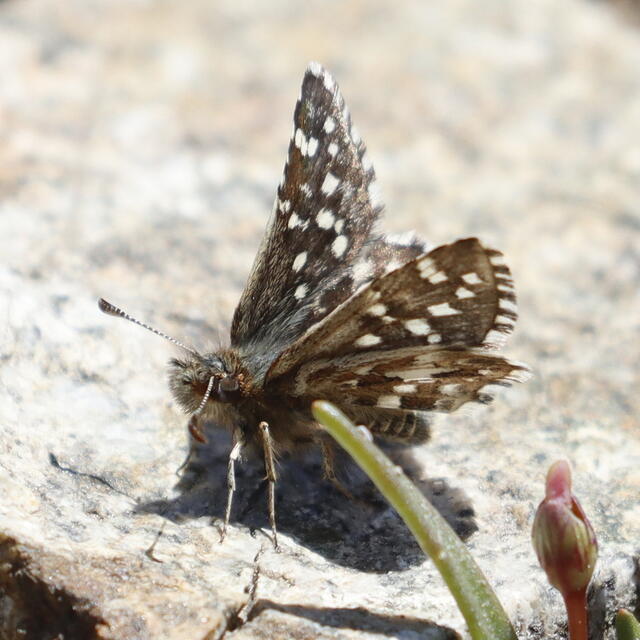Two-banded Checkered-Skipper
Pyrgus ruralis (Boisduval, 1852)
Family: Hesperiidae
Subfamily: Pyrginae
Identification: Upperside is light-to-blackish brown; forewing has squarish white spots; hindwing usually has 2 rows of white spots. Underside is brown or gray with dull spots that are often obscure. Male has a costal fold enclosing scent scales on the forewing.
Wing Span: 1 - 1 1/8 inches (2.5 - 2.9 cm).
Life History: To find receptive females, males patrol and sometimes perch close to the ground in valley bottoms or swales. Females lay eggs singly on the host plant. Caterpillars make a webbed leaf nest in which they live and feed.
Flight: One brood from April-July.
Caterpillar Hosts: Herbaceous plants in the rose family (Rosaceae) including Drummond's potentilla (Potentilla drummondii), dusky horkelia (Horkelia fusca), Santa Rosa horkelia (H. tenuiloba), Cleveland's horkelia (H. bolanderi clevelandii), and probably others.
Adult Food: Flower nectar.
Habitat: Forest clearings, meadows, pastures, streamsides; from sea level to 10,000 feet.
Range: Inconspicuous, usually local and uncommon. South in the mountains from British Columbia and Alberta to southern California, Arizona, and New Mexico.
Conservation: The Laguna Mountains skipper (subspecies lagunae) is on the Endangered Species list and needs careful study of its conservation needs.
NCGR: G4 - Apparently secure globally, though it might be quite rare in parts of its range, especially at the periphery.
Management Needs: Habitat of the Laguna Mountains skipper requires periodic disturbance such as light grazing and small controlled burns.
Comments: NULL
Please donate!
We depend on donations to keep Butterflies and Moths of North America freely available. We want to express our gratitude to all who showed their support by making a contribution this year. You can donate to support this project at any time.
Advertise with us!
Do you have a product or service that you think would interest BAMONA users? If you would like to advertise on this website, contact us by email, or use the contact form and select the "Advertising" category.
Verified Sightings
Displaying 1 - 24 of 391 verified sightings

Observation date: Jun 03, 2025
Submitted by: Buddy Mays
Region: Jefferson County, Oregon, United States
Verified by: Ken Davenport
Verified date: Jun 08, 2025

Observation date: May 21, 2025
Submitted by: gp
Region: Lane County, Oregon, United States
Verified by: Ken Davenport
Verified date: Jun 04, 2025

Observation date: May 28, 2025
Submitted by: jrmbutterfly
Region: British Columbia, Canada
Verified by: Paul Prappas
Verified date: May 31, 2025

Observation date: May 01, 2025
Submitted by: Paul Prappas
Region: British Columbia, Canada
Verified by: Paul Prappas
Verified date: May 01, 2025

Observation date: Apr 24, 2025
Submitted by: Buddy Mays
Region: Jefferson County, Oregon, United States
Verified by: Ken Davenport
Verified date: Apr 27, 2025

Observation date: Apr 26, 2025
Submitted by: Varn
Region: Jefferson County, Washington, United States
Verified by: davidwdroppers
Verified date: Apr 26, 2025

Observation date: Apr 23, 2025
Submitted by: sandyleapt
Region: Benton County, Oregon, United States
Verified by: Ken Davenport
Verified date: Apr 24, 2025

Observation date: Apr 18, 2025
Submitted by: weflybye
Region: Thurston County, Washington, United States
Verified by: davidwdroppers
Verified date: Apr 19, 2025

Observation date: May 31, 2005
Submitted by: papilio1
Region: Sierra County, California, United States
Verified by: Ken Davenport
Verified date: Dec 01, 2024

Observation date: Apr 23, 1984
Submitted by: papilio1
Region: Butte County, California, United States
Verified by: Ken Davenport
Verified date: Dec 01, 2024

Observation date: Aug 03, 2024
Submitted by: weflybye
Region: Mason County, Washington, United States
Verified by: davidwdroppers
Verified date: Aug 04, 2024

Observation date: Jun 25, 2024
Submitted by: Lupine1
Region: Pierce County, Washington, United States
Verified by: davidwdroppers
Verified date: Jun 28, 2024

Observation date: Jun 09, 2024
Submitted by: weflybye
Region: Mason County, Washington, United States
Verified by: davidwdroppers
Verified date: Jun 14, 2024

Observation date: May 27, 2024
Submitted by: jrmbutterfly
Region: British Columbia, Canada
Verified by: Paul Prappas
Verified date: Jun 10, 2024

Observation date: May 27, 2024
Submitted by: jrmbutterfly
Region: British Columbia, Canada
Verified by: Paul Prappas
Verified date: Jun 10, 2024

Observation date: Jun 07, 2024
Submitted by: dfagan746
Region: Jefferson County, Oregon, United States
Verified by: Ken Davenport
Verified date: Jun 08, 2024

Observation date: May 12, 2024
Submitted by: wildebynature
Region: British Columbia, Canada
Verified by: Paul Prappas
Verified date: May 27, 2024

Observation date: May 09, 2024
Submitted by: dfagan746
Region: Klickitat County, Washington, United States
Verified by: davidwdroppers
Verified date: May 10, 2024

Observation date: May 07, 2024
Submitted by: shuckabone
Region: Siskiyou County, California, United States
Verified by: Ken Davenport
Verified date: May 07, 2024

Observation date: Apr 19, 2024
Submitted by: hiker96
Region: Thurston County, Washington, United States
Verified by: davidwdroppers
Verified date: Apr 20, 2024

Observation date: Apr 18, 2024
Submitted by: Dobber31
Region: San Mateo County, California, United States
Verified by: Ken Davenport
Verified date: Apr 19, 2024

Observation date: Apr 14, 2024
Submitted by: weflybye
Region: Mason County, Washington, United States
Verified by: davidwdroppers
Verified date: Apr 16, 2024

Observation date: Jul 31, 2023
Submitted by: natureali
Region: Mono County, California, United States
Verified by: Ken Davenport
Verified date: Aug 07, 2023

Observation date: Jul 31, 2023
Submitted by: natureali
Region: Mono County, California, United States
Verified by: Ken Davenport
Verified date: Aug 07, 2023
- 1 of 17
- next ›





